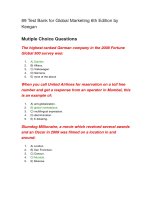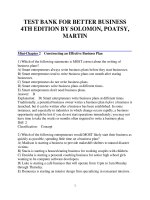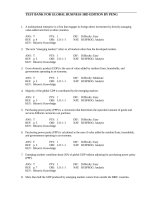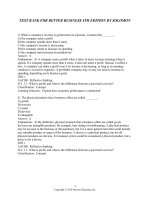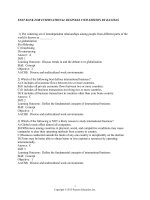Link download test bank for international business 6th edition by wild
Bạn đang xem bản rút gọn của tài liệu. Xem và tải ngay bản đầy đủ của tài liệu tại đây (378.24 KB, 66 trang )
Test Bank for International
Business 6th Edition by Wild
Chapter 2
Cross-Cultural Business
1) Nokia Corporation uses its knowledge of cultures to adapt its mobile handsets
to suit local markets.
Answer: TRUE
Diff: 1 Page Ref: 43
AACSB: Dynamics of the global economy; Multicultural and diversity
understanding
Skill: Concept
Objective: Chapter 2-LO1
2) The first step in analyzing a nation's potential for international business
activity is to examine its customs.
Answer: FALSE
Diff: 1 Page Ref: 44
AACSB: Dynamics of the global economy; Multicultural and diversity
understanding
Skill: Concept
Objective: Chapter 2-LO1
3) Ethnocentricity improves the ability to manage new business practices abroad.
1
Answer: FALSE
Diff: 2 Page Ref: 44
AACSB: Dynamics of the global economy; Multicultural and diversity
understanding
Skill: Concept
Objective: Chapter 2-LO1
4) Democratic nations that value freedom of speech do not regulate
economic sectors such as broadcasting.
Answer: FALSE
Diff: 2 Page Ref: 45
AACSB: Dynamics of the global economy; Multicultural and diversity
understanding
Skill: Concept
Objective: Chapter 2-LO1
5) Subcultures seldom exist in democratic countries with large
populations. Answer: FALSE
Diff: 1 Page Ref: 46
AACSB: Dynamics of the global economy; Multicultural and diversity
understanding
Skill: Concept
Objective: Chapter 2-LO1
6) Subcultures share the same language, lifestyle, values, and attitudes as the
2
dominant culture.
Answer: FALSE
Diff: 2 Page Ref: 46
AACSB: Dynamics of the global economy; Multicultural and diversity
understanding
Skill: Concept
Objective: Chapter 2-LO1
7) Mexican immigrants living in the United States comprise a
subculture. Answer: TRUE
Diff: 1 Page Ref: 46
AACSB: Dynamics of the global economy; Multicultural and diversity
understanding
Skill: Concept
Objective: Chapter 2-LO1
8) All Chinese citizens are fluent in the official Mandarin dialect.
Answer: FALSE
Diff: 2 Page Ref: 46
AACSB: Communication abilities; Dynamics of the global economy;
Multicultural and diversity understanding
Skill: Concept
Objective: Chapter 2-LO1
9) A nation's cultural boundaries do not always correspond to its
political boundaries.
3
Answer: TRUE
Diff: 2 Page Ref: 46
AACSB: Dynamics of the global economy; Multicultural and diversity
understanding
Skill: Concept
Objective: Chapter 2-LO1
10) Some subcultures exist across national
borders. Answer: TRUE
Diff: 2 Page Ref: 46
AACSB: Dynamics of the global economy; Multicultural and diversity
understanding
Skill: Concept
Objective: Chapter 2-LO1
11) The cultural component of aesthetics deals with elements such as
imagery, symbolism, and the arts.
Answer: TRUE
Diff: 1 Page Ref: 47
AACSB: Dynamics of the global economy; Multicultural and diversity
understanding
Skill: Concept
Objective: Chapter 2-LO2
12) Black is the universal color that symbolizes death and mourning.
4
Answer: FALSE
Diff: 2 Page Ref: 47
AACSB: Dynamics of the global economy; Multicultural and diversity
understanding
Skill: Concept
Objective: Chapter 2-LO2
13) When choosing web site addresses or telephone numbers for businesses that
serve Chinese customers, entrepreneurs should attempt to include the number four
(4), which is considered to be particularly lucky in China.
Answer: FALSE
Diff: 2 Page Ref: 48
AACSB: Dynamics of the global economy; Multicultural and diversity
understanding
Skill: Application
Objective: Chapter 2-LO2
14) In today's global business world, the use of a 12-hour clock (as opposed to the
24-hour clock) is universally appropriate.
Answer: FALSE
Diff: 2 Page Ref: 48
AACSB: Dynamics of the global economy; Multicultural and diversity
understanding
Skill: Concept
Objective: Chapter 2-LO2
15) When going global with an Internet presence, it is highly beneficial for a
5
business to localize its web site.
Answer: TRUE
Diff: 2 Page Ref: 48
AACSB: Dynamics of the global economy; Multicultural and diversity
understanding; Use of information technology
Skill: Concept
Objective: Chapter 2-LO2
16) U.S. employees place value on achieving individual results.
Answer: TRUE
Diff: 2 Page Ref: 48
AACSB: Dynamics of the global economy; Multicultural and diversity
understanding
Skill: Concept
Objective: Chapter 2-LO2
17) A culture's values tend to be rigid over time.
Answer: TRUE
Diff: 2 Page Ref: 49
AACSB: Dynamics of the global economy; Multicultural and diversity
understanding
Skill: Concept
Objective: Chapter 2-LO2
18) Many folk customs that have spread by cultural diffusion to other regions have
6
developed into popular customs.
Answer: TRUE
Diff: 1 Page Ref: 52
AACSB: Dynamics of the global economy; Multicultural and diversity
understanding
Skill: Concept
Objective: Chapter 2-LO2
19) The concept of nuclear family that prevails in much of Europe
includes grandparents, uncles, aunts, and cousins.
Answer: FALSE
Diff: 2 Page Ref: 53
AACSB: Dynamics of the global economy; Multicultural and diversity
understanding
Skill: Concept
Objective: Chapter 2-LO2
20) Status refers to the way a culture divides its population according to positions
within its social structure.
Answer: TRUE
Diff: 1 Page Ref: 54
AACSB: Dynamics of the global economy; Multicultural and diversity
understanding
Skill: Concept
Objective: Chapter 2-LO2
21) Religion strongly affects the kinds of goods and services acceptable to Muslim
consumers.
7
Answer: TRUE
Diff: 2 Page Ref: 58
AACSB: Dynamics of the global economy; Multicultural and diversity
understanding
Skill: Concept
Objective: Chapter 2-LO2
22) Hindus and Buddhists both seek "nirvana," a state of eternal happiness.
Answer: TRUE
Diff: 3 Page Ref: 58
AACSB: Dynamics of the global economy; Multicultural and diversity
understanding
Skill: Concept
Objective: Chapter 2-LO2
23) French is the most widely used "lingua franca" in international
business. Answer: FALSE
Diff: 2 Page Ref: 62
AACSB: Communication abilities; Dynamics of the global economy;
Multicultural and diversity understanding
Skill: Concept
Objective: Chapter 2-LO2
24) Literacy tests offer a reliable basis on which to compare one nation's
education level to another's.
8
Answer: FALSE
Diff: 3 Page Ref: 64
AACSB: Communication abilities; Dynamics of the global economy;
Multicultural and diversity understanding
Skill: Concept
Objective: Chapter 2-LO2
25) Nations that invest in worker training are usually rewarded with
productivity increases and rising incomes.
Answer: TRUE
Diff: 1 Page Ref: 64
AACSB: Dynamics of the global economy; Multicultural and diversity
understanding
Skill: Concept
Objective: Chapter 2-LO2
26) Hong Kong, South Korea, Singapore, and Taiwan have experienced
rapid economic development despite their poor education systems.
Answer: FALSE
Diff: 2 Page Ref: 64
AACSB: Dynamics of the global economy; Multicultural and diversity
understanding
Skill: Concept
Objective: Chapter 2-LO2
27) Material culture often displays uneven development across a
nation's industries.
9
Answer: TRUE
Diff: 2 Page Ref: 65
AACSB: Dynamics of the global economy; Multicultural and diversity
understanding; Use of information technology
Skill: Concept
Objective: Chapter 2-LO4
28) Group-oriented cultures are typically found in Europe and North
America. Answer: FALSE
Diff: 2 Page Ref: 68
AACSB: Dynamics of the global economy; Multicultural and diversity
understanding
Skill: Concept
Objective: Chapter 2-LO5
29) In cultures with large power distance, prestige and rewards tend to be equally
shared between superiors and rank-and-file employees.
Answer: FALSE
Diff: 3 Page Ref: 68
AACSB: Dynamics of the global economy; Multicultural and diversity
understanding
Skill: Concept
Objective: Chapter 2-LO5
30) Cultures that score low on uncertainty avoidance tend to be more open to
10
change and new ideas.
Answer: TRUE
Diff: 3 Page Ref: 69
AACSB: Dynamics of the global economy; Multicultural and diversity
understanding
Skill: Concept
Objective: Chapter 2-LO5
31) Typically, the first step in the process of analyzing a nation's potential as a
host for international business activity is to ________.
A) assess its overall business climate
B) analyze its religious environment
C) investigate its history of corruption
D) evaluate its legal system
Answer: A
Diff: 2 Page Ref: 44
AACSB: Dynamics of the global economy; Multicultural and diversity
understanding
Skill: Concept
Objective: Chapter 2-LO1
32) Which of the following terms is defined as the set of values, beliefs, rules,
and institutions held by a specific group of people?
A) Customs
B) Rituals
C) Culture
11
D) Aesthetics
Answer: C
Diff: 1 Page Ref: 44
AACSB: Dynamics of the global economy; Multicultural and diversity
understanding
Skill: Concept
Objective: Chapter 2-LO1
33) The belief that one's own ethnic group or culture is superior to that of others
is referred to as ________.
A) cultural inheritance
B) cultural diffusion
C) cultural literacy
D) ethnocentricity
Answer: D
Diff: 1 Page Ref: 44
AACSB: Dynamics of the global economy; Multicultural and diversity
understanding
Skill: Concept
Objective: Chapter 2-LO1
34) Which of the following is the best example of a case in which ethnocentricity
undermines an international business project?
A) International investors avoid investing in an Indian company because they
are unsure of India's committment to free markets.
12
B) Production falls at a U.S.-owned factory in Japan because workers
react negatively to American management techniques.
C) China relies on its natural resources and inexpensive factory labor to promote
its country's economic development.
D) Korean managers of a manufacturing company are sent to East European
plants to learn the work habits of local workers.
Answer: B
Diff: 3 Page Ref: 44
AACSB: Dynamics of the global economy; Multicultural and diversity
understanding
Skill: Application
Objective: Chapter 2-LO1
35) Detailed knowledge about a culture that enables people to live and work
within that culture is called ________.
A) cultural literacy
B) social mobility
C) cultural diffusion
D) aesthetics
Answer: A
Diff: 1 Page Ref: 44
AACSB: Dynamics of the global economy; Multicultural and diversity
understanding
Skill: Concept
Objective: Chapter 2-LO1
36) Which one of the following best supports the argument that ethnocentricity
13
should be avoided in business relationships with other countries?
A) Managers often need time to learn the traits and work habits of other cultures.
B) Cultural literacy can only be gained through fluency in another
country's language.
C) Managers from other cultures understand best how to motivate their
own employees.
D) Western management principles have been proven to enhance
business productivity.
Answer: C
Diff: 3 Page Ref: 45
AACSB: Dynamics of the global economy; Multicultural and diversity
understanding; Reflective thinking skills
Skill: Critical Thinking
Objective: Chapter 2-LO1
37) A critic argues that the French government is too restrictive regarding its
limitations on English language usage in product packaging. Which of the following
would most likely reflect the French government's response to the critic?
A) The limitations are designed to stop the diffusion of French traits across
European borders.
B) The limitations will decrease over time as France earns more income
through international trade.
C) The limitations are necessary to preserve unique elements of French
national culture.
D) The limitations are focused primarily on British imports and do not affect
U.S.-made products.
Answer: C
Diff: 2 Page Ref: 45-46
14
AACSB: Dynamics of the global economy; Multicultural and diversity
understanding; Reflective thinking skills
Skill: Critical Thinking
Objective: Chapter 2-LO1
38) Which of the following is best defined as a group of people who share a unique
way of life within a larger dominant culture?
A) Caste system
B) Subculture
C) Collective culture
D) Material culture
Answer: B
Diff: 1 Page Ref: 46
AACSB: Dynamics of the global economy; Multicultural and diversity
understanding
Skill: Concept
Objective: Chapter 2-LO1
39) Which of the following terms is used to refer to that which a culture
considers to be in "good taste" in the arts?
A) Customs
B) Social structure
C) Manners
D) Aesthetics
Answer: D
15
Diff: 1 Page Ref: 47
AACSB: Dynamics of the global economy; Multicultural and diversity
understanding
Skill: Concept
Objective: Chapter 2-LO2
40) An electronics manufacturer is designing a product to be marketed to
consumers in Islamic countries. Which of the following colors should the company
use most prominently in its packaging to make a favorable impression on buyers?
A) Green
B) White
C) Black
D) Orange
Answer: A
Diff: 2 Page Ref: 47
AACSB: Dynamics of the global economy; Multicultural and diversity
understanding
Skill: Application
Objective: Chapter 2-LO2
41) Which color is primarily associated with funerals in
Japan? A) Black
B) White C)
Jade D) Tan
Answer: B
16
Diff: 2 Page Ref: 47
AACSB: Dynamics of the global economy; Multicultural and diversity
understanding
Skill: Application
Objective: Chapter 2-LO2
42) Which of the following terms is used to refer to the ideas, beliefs, and
customs to which people are emotionally attached?
A) Aesthetics
B) Social structure
C) Manners
D) Values
Answer: D
Diff: 2 Page Ref: 48
AACSB: Dynamics of the global economy; Multicultural and diversity
understanding
Skill: Concept
Objective: Chapter 2-LO2
43) The United Kingdom and the United States value ________, whereas
Japan and South Korea value ________.
A) the caste system; the class system
B) aesthetics; ethnocentricity
C) individual freedom; group consensus
D) hard work; leisure
17
Answer: C
Diff: 3 Page Ref: 48
AACSB: Dynamics of the global economy; Multicultural and diversity
understanding
Skill: Concept
Objective: Chapter 2-LO2
44) Which of the following terms is used to refer to the positive or negative
evaluations, feelings, and tendencies that individuals harbor toward objects or
concepts?
A) Customs
B) Attitudes
C) Manners
D) Values
Answer: B
Diff: 1 Page Ref: 48
AACSB: Dynamics of the global economy; Multicultural and diversity
understanding
Skill: Concept
Objective: Chapter 2-LO2
45) Which of the following statements is true regarding
attitudes? A) They are quite rigid over time compared to values.
B) They are learned from role models.
C) They are similar from one country to the next because they form within
a cultural context.
18
D) They are developed only toward the most important aspects of
life. Answer: B
Diff: 3 Page Ref: 49
AACSB: Dynamics of the global economy; Multicultural and diversity
understanding
Skill: Concept
Objective: Chapter 2-LO2
46) Which of the following terms is used to refer to any element that represents a
culture's way of life, including gestures, material objects, traditions, and concepts?
A) Intangible product
B) Tangible product
C) Aesthetic
D) Cultural
trait Answer: D
Diff: 2 Page Ref: 49
AACSB: Dynamics of the global economy; Multicultural and diversity
understanding
Skill: Concept
Objective: Chapter 2-LO2
47) Which of the following statements regarding cultural change is NOT true?
A) Cultural change occurs as new traits are accepted and absorbed into a
culture. B) Cultural diffusion occurs quickly in almost every culture.
C) Globalization is increasing the pace of cultural diffusion.
19
D) Technological advances are increasing the pace of cultural
diffusion. Answer: B
Diff: 3 Page Ref: 49-50
AACSB: Dynamics of the global economy; Multicultural and diversity
understanding
Skill: Concept
Objective: Chapter 2-LO2
48) Which of the following refers to the process whereby cultural traits
spread from one culture to another?
A) Cultural imperialism
B) Social mobility
C) Cultural diffusion
D) Cultural literacy
Answer: C
Diff: 2 Page Ref: 49
AACSB: Dynamics of the global economy; Multicultural and diversity
understanding
Skill: Concept
Objective: Chapter 2-LO2
49) ________ refers to the replacement of one culture's traditions, folk heroes, and
artifacts with substitutes from another.
A) Cultural imperialism
B) Acculturation
C) Cultural attrition
20
D) Cultural immersion
Answer: A
Diff: 1 Page Ref: 50
AACSB: Dynamics of the global economy; Multicultural and diversity
understanding
Skill: Concept
Objective: Chapter 2-LO2
50) Companies that wish to avoid the charge of cultural imperialism should
do which of the following?
A) Be sensitive to how their activities and products affect people's traditional
ways and habits
B) Quickly launch new management practices to avoid prolonged resistance to
change
C) Implement new investment projects and management practices only
during volatile times
D) Maintain a standardized approach to strategy with policy decisions made
at headquarters
Answer: A
Diff: 2 Page Ref: 50
AACSB: Dynamics of the global economy; Multicultural and diversity
understanding
Skill: Application
Objective: Chapter 2-LO2
51) When Russian politicians complain about the Snickerization of their
culture, they are complaining about which of the following?
21
A) Lingua franca
B) Social mobility
C) Cultural identification
D) Cultural imperialism
Answer: D
Diff: 2 Page Ref: 50
AACSB: Dynamics of the global economy; Multicultural and diversity
understanding
Skill: Concept
Objective: Chapter 2-LO2
52) When a manager walks employees through every step of an assignment and
monitors the results at each stage, this process is called ________.
A) diffusion management
B) situational management
C) mentoring and training
D) workforce mobility
Answer: B
Diff: 2 Page Ref: 51
AACSB: Dynamics of the global economy; Multicultural and diversity
understanding
Skill: Concept
Objective: Chapter 2-LO2
53) Which of the following terms is used to refer to appropriate ways of
behaving, speaking, and dressing in a culture?
22
A) Attitudes
B) Manners
C) Aesthetics
D) Values
Answer: B
Diff: 1 Page Ref: 51
AACSB: Communication abilities; Dynamics of the global economy;
Multicultural and diversity understanding
Skill: Concept
Objective: Chapter 2-LO3
54) A group of senior managers decides to require members of their new
Mexican office to take a course in business etiquette. Several employees speak
out against the idea, arguing that the course is a waste of time. Which of the
following would be the most effective response to the employees?
A) Business people are likely to be understanding if a mistake is made by someone
outside the culture.
B) Most business meetings are held on company property during work time,
not during lunch.
C) It is important for business success to display culturally appropriate behavior
in social settings.
D) Non-native speakers may have difficulty understanding the nuances
of negotiations in Spanish.
Answer: C
Diff: 3 Page Ref: 51
AACSB: Dynamics of the global economy; Multicultural and diversity
understanding; Reflective thinking skills
23
Skill: Critical Thinking
Objective: Chapter 2-LO3
55) Arab culture considers the left hand the "________"
hand. A) eating
B) writing
C) personal hygiene
D) greeting
Answer: C
Diff: 3 Page Ref: 51
AACSB: Dynamics of the global economy; Multicultural and diversity
understanding
Skill: Concept
Objective: Chapter 2-LO3
56) Which of the following terms is used to refer to habits or ways of behaving
in specific circumstances that are passed down through generations?
A) Customs
B) Attitudes
C) Values
D) Manners
Answer: A
Diff: 2 Page Ref: 52
AACSB: Dynamics of the global economy; Multicultural and diversity
understanding
Skill: Concept
24
Objective: Chapter 2-LO3
57) Sharing food gifts during the Islamic holy month of Ramadan is an example
of a(n) ________.
A) custom
B) value
C) ritual
D) attitude
Answer: A
Diff: 2 Page Ref: 52
AACSB: Dynamics of the global economy; Multicultural and diversity
understanding
Skill: Application
Objective: Chapter 2-LO3
58) Which of the following terms is used to refer to behavior that is shared by a
heterogeneous group or by several groups?
A) Manners
B) Lingua franca
C) Popular custom
D) Folk custom
Answer: C
Diff: 2 Page Ref: 52
AACSB: Dynamics of the global economy; Multicultural and diversity
understanding
25


